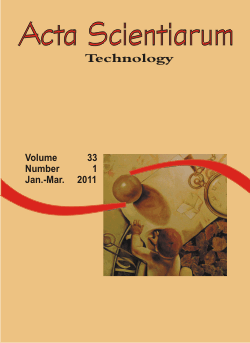<b>Development and characterization of the tangerine peel liquor with different alcoholic bases</b> - doi: 10.4025/actascitechnol.v33i1.7873
DOI:
https://doi.org/10.4025/actascitechnol.v33i1.7873Palavras-chave:
Liquor, sugar cane spirit, tangerine spirit, grain alcoholResumo
This study aimed to produce and characterize a liquor of tangerine peel with three alcoholic bases (grain alcohol, sugar cane spirit and tangerine spirit). The physical and chemical analyses were performed relative to volatile acidity, dry extract, density and alcohol degree. The density in all samples was 1.13 g mL-1, volatile acidity 48.54 g 100 mL-1 for the treatment with grain alcohol, 28.43 g 100 mL-1 with spirit sugar cane and 22.09 g 100 mL-1 for the tangerine spirit treatment. The dry extract ranged from 431 g L-1 for grain alcohol treatment, 446.26 g L-1 for sugar cane spirit treatment and 443.84 g L-1 for the tangerine spirit treatment, the alcohol degree ranged from 18.84, 20.01 and 19.67 °GL among the treatments. We accomplished an acceptance test through sensory analysis of the following attributes: alcoholic taste, fruit flavor, sweetness and overall impression. The liquor based on grain alcohol produced the highest mean regarding all attributes (6.32, 6.66, 6.34 e 6.26 for taste alcoholic, fruit flavor, sweetness and overall impression, respectively), but without significant difference among the treatments. In conclusion, the tangerine peel liquor made using the own fruit spirit is a viable alternative for the total use of the fruit and can be a source of income for small farmers. Nevertheless, further studies are necessary to develop of this product.Downloads
Downloads
Arquivos adicionais
Publicado
Como Citar
Edição
Seção
Licença
DECLARAÇíO DE ORIGINALIDADE E DIREITOS AUTORAIS
Declaro que o presente artigo é original, não tendo sido submetido í publicação em qualquer outro periódico nacional ou internacional, quer seja em parte ou em sua totalidade.
Os direitos autorais pertencem exclusivamente aos autores. Os direitos de licenciamento utilizados pelo periódico é a licença Creative Commons Attribution 4.0 (CC BY 4.0): são permitidos o compartilhamento (cópia e distribuição do material em qualqer meio ou formato) e adaptação (remix, transformação e criação de material a partir do conteúdo assim licenciado para quaisquer fins, inclusive comerciais.
Recomenda-se a leitura desse link para maiores informações sobre o tema: fornecimento de créditos e referências de forma correta, entre outros detalhes cruciais para uso adequado do material licenciado.















